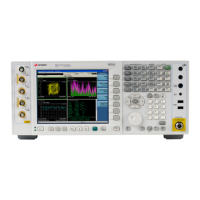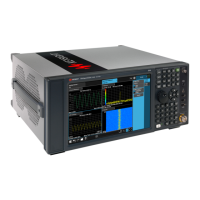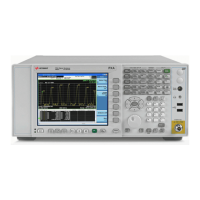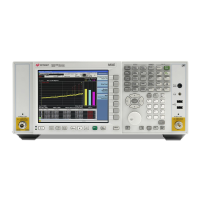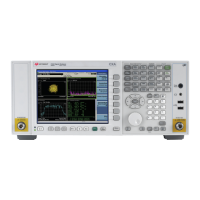3 Spectrum Analyzer Mode
3.2 Swept SA Measurement
More Information
Normalize is most useful for applying correction data to a trace while making a
stimulus-response measurement with a tracking generator (or synchronized
source). For example, connect the cables and a through line, in place of the device
to be measured, between the tracking generator and the instrument input. Notice
that the frequency response is not perfectly flat, showing the response of the cables,
as well as the flatness of both the tracking generator and the instrument. Now press
Store Ref (1→ 3), NormalizeOn. Notice that the displayed trace is now flat, or
normalized. The position of the normalized trace can now be moved to a different
position on the display by changing the normalized reference position. This may be
useful if the device to be tested has positive gain, such as an amplifier. Now replace
the through line with the device under test, and an accurate measurement of the
gain or loss can be made.
Normalize can also be used to perform a scalar reflection measurement (return
loss). In this case a directional coupler or bridge is used to extract the reflected
signal. In the simplest reflection measurement, a Short is placed at the end of the
cable and the result is stored to trace 3 (as before). When Normalize is turned on,
the result is the calibrated return loss in dB. For a more accurate calibration, an
Open and Short can be used. To do the Open/Short calibration, the Open/Short key
at the bottom of the Normalize menu is pressed. This will initiate a guided
calibration procedure which captures the reference trace. This is then stored to
Trace 3, as before. When Normalize is turned on the corrected return loss is
displayed.
Measurement Details
First the following calculation is performed:
Trace 1 = (Trace 1D – Normalized Trace)
Where:
–
Trace 1D is the measured value of trace 1, as it comes from the SENSe
subsystem
–
Normalized Trace is Trace 3, in which you have previously stored a reference
trace
–
All values are in decibel units
This Trace 1 contains the values that will be returned from a trace query, or if the
marker is placed on the trace.
Forexample,let'ssaybucket1onTrace1isat0dBm,andbucket1onTrace3isat
10 dBm.The resultant bucket is at 0 dBm – 10 dBm = –10 dB (just like with a delta
marker).
Spectrum Analyzer Mode User's &Programmer's Reference 541

